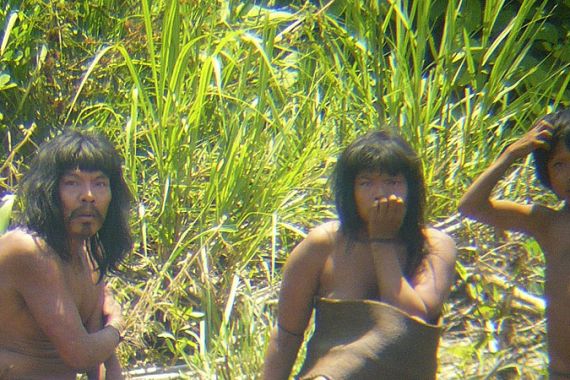Peru struggles to protect Indian tribe
Unwelcome visitors and logging force the Mashco-Piro out of hiding as new images reveal a community under threat.

Peruvian authorities say they are struggling to keep outsiders away from a previously isolated Amazon people who began appearing on the banks of a river popular with environmental tourists.
The advocacy group Survival International released photos on Tuesday showing members of the Mashco-Piro tribe on the river bank, described as the most detailed sightings of uncontacted indigenous people ever recorded on camera.
Keep reading
list of 4 itemsAfter the Hurricane
World’s coral reefs face global bleaching crisis
Why is Germany maintaining economic ties with China?
Speaking to Al Jazeera, Survival International’s Rebecca Spooner said the release of the photographs comes on the back of increased violence as the tribe looks to steer away outsiders, including curious onlookers and logging and mining companies who are trying to force them off their land.
The UK-based group provided the photos exactly a year after releasing aerial photos from Brazil of another tribe classified as uncontacted, one of about 100 such groups it says still exist around the world.
“We really want to highlight this volatile situation so as to put pressure on the Peruvian government to do something,” Spooner said.
“They were known to be a peaceful tribe up until 2001 but there has been an increasing level of violence when they started shooting at people with bows and arrows because they started coming under increasing threat as their land became encroached upon”.
Bow-and-arrow attacks
Tribe members have been blamed for two bow-and-arrow attacks. One badly wounded a forest ranger in October. The following month, another fatally pierced the heart of Nicolas “Shaco” Flores, an indigenous person from the Matsiguenka tribe, who had long maintained a relationship with the Mashco-Piro.
|
Survival International’s Rebecca Spooner on the dangers facing the tribe |
One of the Mashco-Piro photos was taken by a bird watcher in August, Survival International said.
Others were shot by Spanish archaeologist Diego Cortijo on November 16, six days before Flores was killed.
The Mashco-Piro tribe is believed to number in the hundreds and lives in Peru’s Manu National Park.
The part of the Mashco-Piro tribe that showed up at the river is believed to number about 60, including some 25 adults, according to Carlos Soria, a professor at Lima’s Catholic University who used to run Peru’s park protection agency.
The Mashco-Piro live by their own social code, which Soria said includes the practice of kidnapping other tribes’ women and children.
“Isolated tribes never show themselves,” Soria said. “But if this group is doing so it is because they have a certain capacity to defend and protect themselves. They don’t fear people from outside.”
Valuable land targetted
The Mashco-Piro are believed to be one of about 15 uncontacted tribes in Peru that together are estimated to number between 12,000 and 15,000 people living in jungles east of the Andes.
Beatriz Huerta, an anthropologist who works with Peru’s agency for indigenous affairs, speculated that the tribe left the relative safety of their tribe’s jungle home because their habitat was becoming increasingly encroached upon.
“To the west of the territories of the Mashco-Piro in Madre de Dios is the basin of the Urubamba river,” Huerta said.
“That’s where the oil and gas drilling project of Camisea is located. We are very worried because there is a great possibility that the helicopters flying over are scaring the animals away. These animals are the source of food for indigenous people.”
Experts were concerned the tribe may be decimated by a disease borne by outsiders, as has occurred with other uncontacted peoples, but it is still a mystery to them why the Mashco-Piro have appeared in an area so heavily trafficked.
After the first sightings, and after tourists left clothing for the Mashco-Piro, state authorities issued a directive in August barring all boats from going ashore in the area. But enforcing it has been difficult as there is no effective policing.